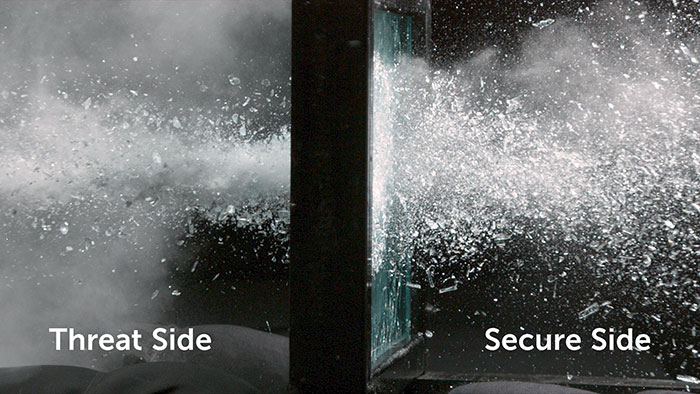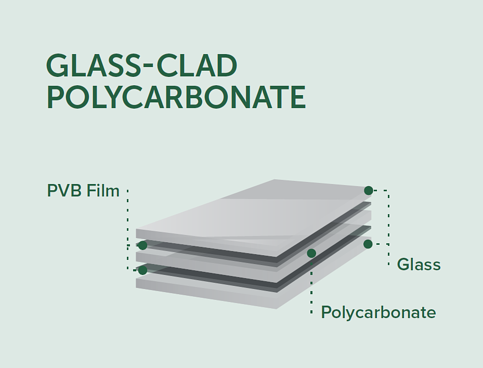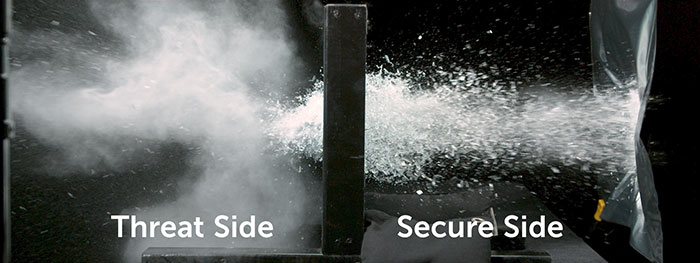What You Should Know About Spalling in Ballistic Glass
 Other News
Other News Subscribe to FREE newsletter
Subscribe to FREE newsletter
| Sep 14, 2022 |
You have a number of decisions ahead of you when planning a security project, especially if you intend to incorporate bulletproof glass into your system. Bullet resistance is offered at several different levels of protection, with a variety of options and accessories that can be incorporated into the setup.
As we discussed in a previous blog post, The 5 Types of Bulletproof Glass Used Today, there is a wide range of security glass products being utilized in various settings, depending on a customer’s specific needs. While protection level is often the biggest concern while planning a project, spalling is an important aspect of ballistic glass that should not be overlooked.
WHAT IS SPALL?
In the world of bullet-resistant glazing, “spall” refers to the fragments of glazing material that may be ejected from ballistic panels as the result of a bullet impact. Spall quantity is directly related to the type of material used in the construction of the panel, with some materials producing more spall than others. Some, like acrylic and actual glass, can produce a significant amount of spall. Other materials, such as laminated polycarbonate, typically produce no spall at all. It’s also important to note that bulletproof products may have a specifically identified “threat” side as well as a “secure” side when discussing the effects of spall. The secure side of the panel is where the people being protected are located.

WHY IS SPALL A CONCERN?
 Let’s use glass-clad polycarbonate, or GCP, to help illustrate why spalling can be a concern. Depending upon the level desired, glass-clad polycarbonate is typically constructed with as few as four and as many as eight layers of glass and/or polycarbonate sandwiched together and held in place by a proprietary Polyvinyl Butyral (PVB) adhesive between each layer. It is often used in exterior applications because the outer glass layers make it more durable and easier to maintain than acrylic or laminated polycarbonate. When hit by a bullet, GCP emits spall from the struck glass panel on the threat side, where the shooter is located. This same effect can happen on the secure side.
Let’s use glass-clad polycarbonate, or GCP, to help illustrate why spalling can be a concern. Depending upon the level desired, glass-clad polycarbonate is typically constructed with as few as four and as many as eight layers of glass and/or polycarbonate sandwiched together and held in place by a proprietary Polyvinyl Butyral (PVB) adhesive between each layer. It is often used in exterior applications because the outer glass layers make it more durable and easier to maintain than acrylic or laminated polycarbonate. When hit by a bullet, GCP emits spall from the struck glass panel on the threat side, where the shooter is located. This same effect can happen on the secure side.
In the image below, you can see spall on the secure side hitting a thin piece of metal 18 inches behind the glass. Even though the glazing has “caught” and stopped the bullet, spall may still impact a person on the secure side.

The UL 752 Standard for Bullet-Resisting Equipment specifies an allowable amount of spalling. To meet the standard, any spall emitted must not cause injury to someone standing at least 18 inches behind the secure side.
LOW AND NO SPALL OPTIONS
A consideration when having glass on the secure side is the possibility of spall during a ballistic attack. As the bullet strikes and is stopped by the layers of glass and polycarbonate, the kinetic energy from the bullet may still be transferred through the material, potentially resulting in spalling on the secure side. A low spall glazing option mitigates this situation with a special tempered glass that minimizes the amount of spalling that may occur.
A no spall glazing option is available that eliminates spalling with the addition of a polycarbonate back-sheet on the secure side. This flexible polycarbonate layer absorbs the energy transferred from the bullet’s impact and contains any spalling on the secure side.

Our blog post The Benefits of Ballistic Polycarbonate looks at several real-world examples of ballistic polycarbonate applications, such as airports, corporate offices, and municipal and city buildings, as well as detailing how polycarbonate stops high-powered ammunition.
HOW DO I KNOW WHAT TO CHOOSE?
While the no spall option provides superior protection, the softer polycarbonate back-sheet is less resistant to everyday wear than actual glass and can be damaged by ammonia-based cleaning products. When purchasing GCP for your ballistic applications, the benefits and drawbacks of low spall and no-spall options must be given careful consideration. The ballistic experts at Total Security Solutions can help you weigh your options and find the solution that is right for your situation. Reach out to us if you have any questions or if you want to begin a specific security project.
@TSSBulletProof #TSSBulletProof #bulletproof #healthcaresecurity #security #bulletproofglass
For other relevant searches, you might want to try:


